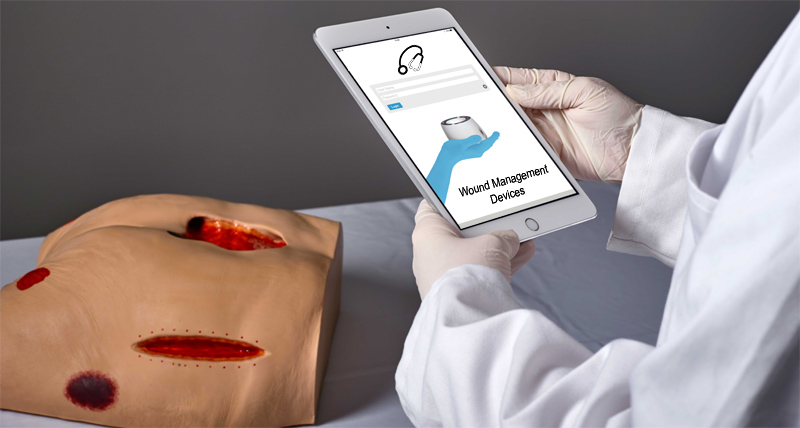
A wound occurs when the skin, the largest organ of the human body, is broken due to some accident or surgery. There are different kinds of wounds but commonly, serious wounds, bleeding wounds, and infectious wounds should be taken care of. Wound management and recovery is a complex and collaborative process that includes pre-cleaning, germ treatment, wound healing, infection prevention, and treatment strategy.
This process is usually done with the collective involvement of doctors, nurses, patients, pathologists, and wound specialists. There is no dearth of the wound management products in the market to treat risky wounds. Billions of individuals all over the world are experiencing wounds and injuries. The items that are related to wound management have been defined to guarantee high protection from natural inhibitors and unfamiliar particles. They are mostly utilized by an attendant under the doctors' guidelines and supervision. Accordingly, the expanding rate of cost-efficient medicines and treatment is boosting the demand for better wound management items.
Wounds can happen because of accidents, burns, injury, trauma, or catastrophic events. They are usually divided into two types, i.e. chronic and acute wounds. Chronic wounds may develop due to various sorts of diseases of life, for instance, obesity, cardiovascular diseases, and diabetes. On the other hand, acute injuries can happen because of surgical or traumatic accidents. These injuries or wounds generally get cure through a conventional process of healing at a reliable rate. However, the number of chronic wounds is foreseen to increase in the coming years.
In the current situation, there are massive advancements in Pharmacology. An agent like ACE restraint has assisted in improving the capacity and personal satisfaction in patients with peripheral arterial disease, a typical circulatory issue, and emphatically affected healing of the wound. Diabetes is one of the major wounds causing diseases. There is more than 25% diabetic person who is aged 65 years or above. The occurrence of wounds that are chronic, specifically foot ulcers are growing among the patients who are suffering from diabetes. These factors will grow the adoption and acceptance of wound management devices in the upcoming years.
There are various kinds of wound dressings, for example, silver-containing hydrophilic fiber dressing, and antibacterial dressings etc. However, on the basis of materials, wound dressings can be classified into foams, gauze, transparent films, alginates, composites, hydrocolloids, hydrogel. These are used very frequently in wound management.
The polymer material is used to make form dressings. Form dressings are often multi-layer structures that consist of an anti-adhesion wound contact layer, infiltration layer, and waterproof and germ-resistant layer. The surface in form dressings is usually covered with a layer of the polymeric semi-permeable membrane. Some of the membranes are self-adhesive and their key ingredient is silica gel. Its action mechanism includes an absorptive form that helps in the absorption of a large number of exudates, decreases infiltration, and provides a moist, warm, and closed environment for the healing of the wound. The form dressings can be advantageous for the management, treatment, and prevention of pressure ulcers, diabetic foot ulcers, skin donor area, mild burn, skin transplant, a venous ulcer, etc. The benefit of foam dressing is that it provides a moist and closed environment for healing and support autolysis debridement.
Braided or non-braided materials such as cotton make gauze dressings. It comes in multiple shapes and sizes. This type of dressing is appropriate for one-time use in cleaning, hemostasis bandaging, or hygienic care of surgical or local wounds. A gauze dressing is really helpful for wound protection, wound infection, and wound exudates management. Generally, for many types of wounds, gauze can be used. They are very easily available at a low cost. This type of dressing is cheaper and suitable for various levels of consumption.
Composite dressings are consist of any type of dressing materials, for example, blend of form and gauze, alginate and silver ion dressing, and others. There are various uses for this kind of dressing including one-layer or two-layer dressing. Moreover, composite dressings are helpful in various kinds of wounds. This type of dressing is comparatively a new kind of interactive wound-cleaning dressing. In composite dressing, the outer layer consists of a hydrophobic synthetic fiber material; the core part consists of polypropylene acid ester (SAP). SAP has a great affinity towards proteins and can actively and easily absorb the exudates and necrotic tissues of the wound. This type of dressing is useful for the debridement of rotten granulation wounds and old granulation wounds. Its benefits include it is easy to use with continuous debridement, accelerating necrotic tissue exfoliation, controlling germ infecting, and promoting the healing cycle of the wound.
Wound management devices are generally used to treat and heal wounds that are complex and chronic. Wounds and injuries are very common among people all over the world. Increasing accidents, wounds, and injuries across the world have driven the growth of the wound management devices market and these factors will continue to propel the market growth in the years to come. The Global Wound Management Devices Market size is expected to grow at a market growth of 7.2% CAGR during the forecast period.